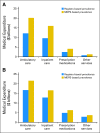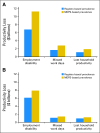Economic burden of cancer survivorship among adults in the United States
- PMID: 24043731
- PMCID: PMC3795887
- DOI: 10.1200/JCO.2013.49.1241
Economic burden of cancer survivorship among adults in the United States
Abstract
Purpose: To present nationally representative estimates of the impact of cancer survivorship on medical expenditures and lost productivity among adults in the United States.
Methods: Using the 2008 to 2010 Medical Expenditure Panel Survey, we identified 4,960 cancer survivors and 64,431 individuals without a history of cancer age ≥ 18 years. Direct medical costs were measured using annual health care expenditures and examined by source of payment and service type. Indirect morbidity costs were estimated from lost productivity as a result of employment disability, missed work days, and lost household productivity. We evaluated the economic burden of cancer survivorship by estimating excess costs among cancer survivors, stratified by time since diagnosis (recently diagnosed [≤ 1 year] and previously diagnosed [> 1 year]), compared with individuals without a history of cancer using multivariable regression models stratified by age (18 to 64 and ≥ 65 years), controlling for age, sex, race/ethnicity, education, and comorbidities.
Results: In 2008 to 2010, the annual excess economic burden of cancer survivorship among recently diagnosed cancer survivors was $16,213 per survivor age 18 to 64 years and $16,441 per survivor age ≥ 65 years. Among previously diagnosed cancer survivors, the annual excess burden was $4,427 per survivor age 18 to 64 years and $4,519 per survivor age ≥ 65 years. Excess medical expenditures composed the largest share of the economic burden among cancer survivors, particularly among those recently diagnosed.
Conclusion: The economic impact of cancer survivorship is considerable and is also high years after a cancer diagnosis. Efforts to reduce the economic burden caused by cancer will be increasingly important given the growing population of cancer survivors.
Conflict of interest statement
Authors' disclosures of potential conflicts of interest and author contributions are found at the end of this article.
Figures



References
-
- Siegel R, DeSantis C, Virgo K, et al. Cancer treatment and survivorship statistics, 2012. CA Cancer J Clin. 2012;62:220–241. - PubMed
-
- Centers for Disease Control and Prevention. Cancer survivors–United States, 2007. MMWR Morb Mortal Wkly Rep. 2011;60:269–272. - PubMed
-
- Hewitt M, Greenfield S, Stovall E. From Cancer Patient to Cancer Survivor: Lost in Transition. Washington, DC: The National Academies Press; 2005.
-
- Ng AK, Travis LB. Second primary cancers: An overview. Hematol Oncol Clin North Am. 2008;22:271–289. - PubMed
-
- Oeffinger KC, Bhatia S. Second primary cancers in survivors of childhood cancer. Lancet. 2009;374:1484–1485. - PubMed
Publication types
MeSH terms
LinkOut - more resources
Full Text Sources
Other Literature Sources
Medical

